MAST - Modic Antibiotic Spinal Therapy
Introduction
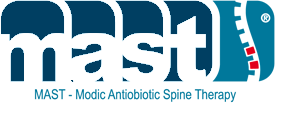 Mr Peter Hamlyn has for the past 2 years been working with a remarkable group of Danish researchers who on the 7th May 2013 will publish ground breaking research into the origins of back pain.
Mr Peter Hamlyn has for the past 2 years been working with a remarkable group of Danish researchers who on the 7th May 2013 will publish ground breaking research into the origins of back pain.
Led by Dr Hanne Albert they have made an astounding series of discoveries which have led to the advent of MAST (Modic antibiotic spine therapy). This revolutionary, simple, and extraordinarily effective treatment is appropriate to somewhere in the region of 20-40% of all sufferers of chronic low back pain for those with the MAST diagnosis this treatment can cure up to 80% of them.
What is Modic
Modic is an appearance on an MRI scan first described by Michael Modic specialist in spinal radiology from the USA. He described 3 types of Modic.
MRI scanning is complex there are 2 common types of scan - 'T1' and 'T2' weighted images you do not need to know the details of these
Type 1
Modic change is bright on T2 (the right picture) and dark on T1(the left picture)
Type 2
Type 2 Modic change is bright on both T1 and T2 weighted images
Type 3
Type 3 is dark on T1 and T2 weighted images
These are exceedingly Rare
Modic Type 1 is related closely to severe back pain and Modic Type 2 in many instance also. Modic Type 3 is usually pain free.
These modic changes occur in the bone adjacent to the disc, they reflect a reaction to the infection in the disc.
How does the infection cause pain?
The bacteria that live in the disc do so because there is no oxygen. They are so called anaerobic bacteria because they hate oxygen ad will die if they are exposed to it. The disc has no blood supply and provides this anaerobic atmosphere. Just like anaerobic exercise in us produces acid, lactic acid, which is painful, so too do these anaerobic bacteria. Proprianobacter produces proprionic acid. This leeches out of the disc into the boine and corrodes it.
The pain arises because of the acid corroding the bone which then suffers microfractures which are painful. It is the bone that hurts rather than the disc.
What evidence is there that the discs are infected?
Several studies looking at infection in intervertebral discs have been undertaken over many years. The first was by a scientist called Sterling, in Britain and the second large study was by Hannah Albert’s team using laboratories in Britain who specialised in the culture of these specific bacteria.
these studies have shown a variety of anaerobic bacteria that live in intervertebral discs using both traditional culture methods and now, the more modern genetic analysis of disc material.
The culprits are: Propionibacter and Corynebacter are the common organisms infecting discs though several others have been involved. These bacteria have been found in high numbers in discs that are affected by degenerative change. They have never been found in discs not affected by degenerative change.
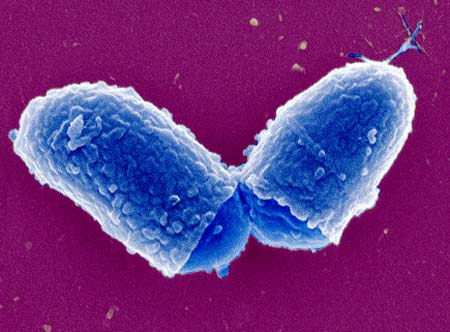 Corynebacter
Corynebacter 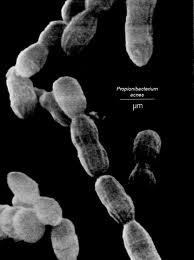 Propionibacter
Propionibacter
How can I find out if I have Modic-related back pain?
You need an MRI scan. The MRI scan has to be interpreted by someone trained too identify 'Modic changes'. In addition you need to be in the hands of a clinician who recognises the clinical syndrome of Modic-related back pain described above, i.e. someone who can differentiate your pattern of pain from the normal backaches that affect us all.
That is to say it is like many diagnoses in medicine. You need a specialist who understands the different causes of back pain and can differentiate one from the other. That specialist then requires a particular test; in this instance an MRI scan. It is not possible to detect by MRI scanning alone or indeed by the clinical history whether you have Modic-related back pain and are a suitable candidate for MAST. The only way of doing this is to have both the specialist opinion and the MRI scan.
What does MAST treatment involve?
It requires you to take a particular antibiotic three times a day for 100 days. This is a huge undertaking. It is vitally important that the treatment is sustained for as long as prescribed for it takes this long for the antibiotics to soak into the disc in sufficient quantity to kill these low-grade but rather resistant bacteria.
What is the response to MAST?
It takes six to eight weeks for the antibiotics to kill the bacteria and for the inflammation and micro-fractures to start to settle.
It is vitally important that the treatment continues for the full 100 days – i.e. a further four weeks beyond this period.
In addition, it is clear from the Danish results that MAST improvement continues for well over a year.
What else do I need to do to cure my back pain?
For MAST to work it is vital that physical activity is restricted during the treatment phase. It is also important that you take your third dose of antibiotic every day just before going to bed. The explanation for this is given below.
Discs have no blood supply. They get their nutrition by absorbing it from tissue in the vertebral body (spine) adjacent to themselves. When you stand up the pressure on the disc means that fluid and nutrients are pushed out of the disc. Fresh fluids and nutrients enter the disc during the night when you are horizontal and the pressure in the disc is reduced. It is at this phase that the antibiotics are sucked or, more precisely, pushed by the pressure of the surrounding tissues into the disc.
The need to refrain from significant physical activity relates to the micro-fractures. The acids secreted by the bacteria corrode the microstructure of the bone, which sustains fractures. The bone has to heal before you can exercise again. After the 100 days you can begin to very gradually increase the amount of exercise you do. This is known as “pacing”.
How should I “pace” my activities?
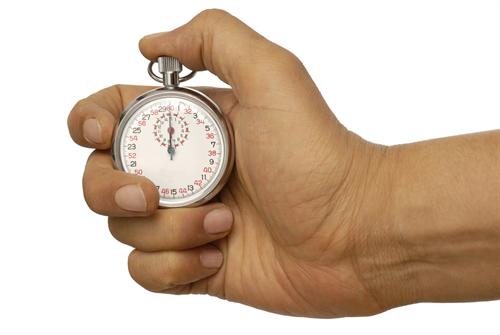 The amount of physical activity you can do is limited; there is a ceiling on the physical activity that your spine can tolerate prior to becoming symptomatic.
The amount of physical activity you can do is limited; there is a ceiling on the physical activity that your spine can tolerate prior to becoming symptomatic.
This ceiling rises as the treatment gets under way.
If you do too much activity and bang your head on the ceiling, it will lower.
Pacing is easy to describe but hard to do. You have to gradually increase the amount of activity you do without banging your head on the ceiling, a ceiling you cannot see. If you are successful you will gradually and smoothly increase the amount of activity you are able to tolerate.
Is MAST expensive?
Modic Antibiotic Spine Therapy is probably the cheapest therapy ever described for severe chronic back pain. Americans spend 20 billion pounds a year on surgery for the spine. Over half a million of them have this surgery. The surgery undoubtedly works. It improves the quality of life.
When comparing the cost-effectiveness of treatments we use QALY’s or Quality Adjusted Life Years. To get one QALY you have to improve a patient’s quality of life materially for a period of one year.Complex surgery for chronic low back pain provides one QALY for every $115, 000.00 spent.
Many patients have their surgery in their middle years. To live a full and active life with surgery you might then conclude that you would have to spend over five million dollars.
For less than 200 dollars, you can have a course of MAST, which is a once-in-a-lifetime treatment offering a cure.
Is MAST good value?
We think so.
Are there risks to MAST?
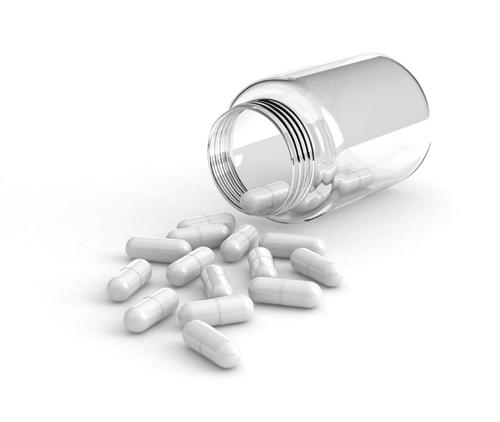 Yes. There are risks to all medical intervention. Antibiotics, particularly when taken over this time, can cause serious problems to the individual. In addition, the indiscriminate use of antibiotics can lead to increased drug resistance, and this is a major concern to all health authorities.
Yes. There are risks to all medical intervention. Antibiotics, particularly when taken over this time, can cause serious problems to the individual. In addition, the indiscriminate use of antibiotics can lead to increased drug resistance, and this is a major concern to all health authorities.
The risks to the individual is principally either an allergic response to the antibiotic concerned or arises as a consequence of the action of the antibiotic on the normal gut flora of bacteria. Most patients will experience an alteration in their bowel habit, developing loose stools. Some will find that they develop thrush as the bacteria from the mouth or perineum (vaginal area particularly) are knocked out by the antibiotic and the yeasts take over to produce thrush. In the bowel, the normal bacteria can be knocked out and others arrive that result in loose stools or even diarrhoea. Rarely, the bowel can be taken over by a bacterium called Clostridium difficile which produces torrential diarrhoea. This is a serious illness. If you develop torrential diarrhoea you need to stop taking the MAST therapy and immediately consult your doctor.
What happens if I do not have MAST?
What happens to patients at present is that they have operations. The Danes have shown that for up to 20-40% of patients currently undergoing surgery for the treatment of chronic low back pain there is another option. This other option is simply to take medication in the form of antibiotics. For up to 80% of those patients who have Modic-related back pain this treatment will work.
What should I do if I think I have Modic?
You should seek the opinion of a specialist who is trained in the diagnosis of Modic-related back pain (MRBP) and in the administration of MAST.
The same team as made these discoveries have established a group (MAST Ltd) dedicated to the education and training of both patients and clinicians. By visiting www.mastmedical.com you will see a globe, upon which is highlighted all the centres that specialise in the MRI scanning of Modic-related back pain and in the delivery of MAST therapy.
Conclusion
The discoveries of Hannah Albert and her team require us to reconsider our understanding of chronic low back pain. The rewriting of our textbooks and the retraining of our doctors is under way.
They have described a discrete clinical syndrome, Modic-related back pain, a specific diagnostic test (MRI scanning) and an effective and low risk therapy.
Modic-related low back pain accounts for perhaps 20-40% of all chronic low back pain. One of the commonest causes of disability in our communities, lost working days and ongoing pain, chronic low back pain is an international plague.
The Spine Surgery London is unaware of the Honour System in Denmark. However, if Hannah Albert were a Briton, we would undoubtedly make her a Dame.